|

|
The online version
of
Cacti, Ground Covers & Vines
of the Lower Rio Grande Valley,
TX
Landscape Uses and Identification
By the Native Plant Project
|
Scientific Names
of Species in this book
AGAVE
Agave scabra
Manfreda variegata
CACTI
Acanthocereus pentagonus
Echinocactus setispinus var. setaceus
Echinocactus texenis
Echinocereus berlandieri
Echinocereus blanckii
Echinocereus enneacanthus
Echinocereus papillosus var. angusticeps
Mammillaria heyderi
Mammillaria runyonii
GROUND COVERS
Buchloe dactyloides
Calyptocarpus vialis
Mimosa strigillosa
Phyla incisa
Phyla nodiflora
Portulaca pilosa
Quincula lobata
Siphonoglossa pilosella
VINES
Anredera scandens
Anredera leptostachys
Cardiospermum halicacabum
Ipomoea imperati
Ipomoea pes-caprae
Merremia dissecta
Mikania scandens
Passiflora filipes
Passiflora foetida
Serjania brachycarpa
Tournefortia volubilis
|
TABLE OF CONTENTS
Introduction 2
Selecting Plants 3
Planting 3
Planting and Care of Cacti 4
Planting and Care of Vines and Ground Covers 4
Plant Communities of the Lower Rio Grande Valley 5
AGAVE and CACTI
Rough agave 7
Variegated Huaco 8
Barbedwire Cactus 9
Berlandier's Alicoche 12
Blanck's Alicoche 13
Dumpling Cactus 17
Horse Crippler 11
Nipple Cactus 16
Small Barrel Cactus 10
Strawberry Cactus or Pitaya 14
Yellow Alicoche 15
GROUND COVERS
Buffalo Grass 20
Chisme or Rough Purslane 22
False Honeysuckle or Tube-tongue 18
Frog-Fruit 24
Powderpuff 21
Prostrate Lawnflower 19
Purple Ground Cherry 23
VINES
Alamo Vine 30
Balloon Vine 33
Beach Morning Glory 28
Blue Passion Flower Vine 32
Climbing Hemp Vine 27
Madeira Vine 25
Railroad Vine 29
Serjania 34
Twining Tournefortia 26
Yellow Passion Flower Vine 31
References and Further Reading 35
Ordering Information 36
Native Plant Project 36
Acknowledgments 36
Membership Application 36
|
|
An estimated 1,200 native flowering plant species grow in the Lower Rio Grande Valley, Texas. The Native Plant Project has selected a varied sampling of the native cacti and agaves, ground covers, and vines to be featured in
this handbook.
Plants native to the Lower Rio Grande Valley have advantages over plants brought in from elsewhere. Plants from this region have the genetic factors which ensure greater probability of survival. They are preadapted having evolved to tolerate local climatic extremes, local soils and local diseases and pests. Native plants have evolved with temperature and rainfall extremes and will require less water than exotic plants.
Using native plants helps conserve rarer species which are vanishing due to habitat clearing. Within the four-county (Cameron, Hidalgo, Starr and
Willacy) Lower Rio Grande Valley area over 98% of the natural habitat has been
converted or cleared for urban, agricultural, or industrial use. Establishing rare species in landscapes spreads out the
individuals so one catastrophe cannot take out a species all at once and also provides a reserve seed source in the event the last individuals of a species are eradicated from natural habitat.
Some of our native cacti and agaves, ground covers, and vines are readily available from most nurseries in the Lower Rio Grande Valley. Rarer ones can be found only at the few nurseries specializing in Lower Rio Grande Valley natives. (See list inserted in handbook.) More and different native plants will become available if you demand them. The Native Plant Project will provide sources upon request; the availability of native plants changes as nurseries change their available selections due to demand.
Founded in 1982, the Native Plant Project's purpose is to protect and conserve the native plants (including endangered), habitats and environment of the Lower Rio Grande Valley and promote the use of local native plants in local landscapes. One method it uses is disseminating information about native plants and habitats. Its definition of a native plant is one indigenous to the four-county area of the Lower Rio Grande Valley.
The Native Plant Project encourages the protection of native plants through conserving and restoring native habitats in refuges, natural areas in parks, and wildlife management areas, and private sanctuaries. It works to protect both natural habitat and human-influenced environment. It encourages the conservation of native species through inclusion in local
landscapings. The Native Plant Project works cooperatively with the U.S. Fish and Wildlife Service, Texas Natural Heritage Program, Texas Parks and Wildlife Department and many private organizations toward protecting Endangered Species, including those local natives imperiled but yet unlisted.
The Native Plant Project currently holds general meetings eight times per year. Members are advised of meetings, field trips and other activities through The
Sabal, which conveys information on the native plants habitats, and the environment of the lower Rio Grande Valley. The Native Plant Project periodically updates and issues lists of endangered species of the Lower Rio Grande Valley and checklists of the woody plants.
The choice of a native ground cover, vine or cactus, like any other plant, should be dictated by landscaping need and the desired effect. Given the limits of purpose and site, finding a native plant which will handsomely fulfill every requirement is no problem. Once the choice is made, there remain only a few plant location and planting tips to be observed.
First, get your plants from a reputable, reliable nurseryman. DO NOT transplant from the wild, not only is this rarely successful, it diminishes our threatened natural plant and animal habitat. A healthy, vigorous looking small plant is much preferred over the large one, and smaller specimens suffer less transplant shock. With smaller plants, chances of survival and rapid growth are very high, they are cheaper, and within a year their size equals those which were initially 2 to 3 times larger.
Second, most native plants do well on most Valley soils. Poorly drained areas should be avoided or mounded for drainage and the vine or cacti planted on top of the mound. Also many of our native plants will grow on a site where a large portion of the soil near the root area is covered by blacktop or paving. Make sure the plants have plenty of growing space.
The best times to plant in the Lower Rio Grande Valley are late autumn (to allow for root establishment and dormancy before any freeze) and mid-February after danger of freezing has passed. Planting during the hotter months can be done but requires much more water, care and maintenance and is equally more stressful on the plant and you than planting during the cooler late-autumn through early-spring months.
A hole should be dug sufficiently deep and wide enough to hold the full root system. In very poor soils, it should be wider and deeper.
The depth of the top of the root system should NOT be lower than the top of the hole. It usually kills the plant when it is planted too deep. Remove the plant from the container. If roots are so numerous they are encircling the soil ball, cut the root ball with a sharp knife vertically to encourage the roots to grow outward. After setting the plant in the hole, soil should be added gradually, firming it at the base of the root ball before adding more. The goal is to bring the roots in close contact with the soil to eliminate air pockets.
The soil around the plants must be watered thoroughly after they are set in place. The frequency of watering depends on the type of soil and the amount of rainfall. Even native plants will require frequent watering during our hot summers.
The best advice for caring for a cactus is to mostly leave it alone. Most cultivated cacti die because they are
overwatered. Cacti are adapted to conserve water, and they can survive very long periods of time without being watered. They are physiologically unable to handle frequent watering and, if
overwatered, they will die of a fungal or bacterial rot. A good rule of thumb for cacti grown indoors is to only water them when it is raining outside. Cacti grown outdoors will survive without ever being watered.
Most of our small native cacti, contrary to what one would expect, will not do well if planted in full sun. These cacti occur naturally in the understory of the brush, in the partial shade provided by trees or shrubs. An ideal outdoors setting for these cacti is under a mesquite or huisache tree. An alternative is to plant them on the east side of a building where they will receive only morning sun. Most of our cacti will suffer if subjected to entire days of full sun.
Cactus should be grown only in a very well drained soil or potting mixture. If grown outdoors, they should be planted in a location in which the soil does not remain moist. Be sure that the location does not pond water after rains. If the cactus is to be cultivated in a container, use a very loose potting mix that will drain readily. A good mix contains a lot of sand. Placing a layer of small gravel in the bottom of the container will ensure adequate drainage and aeration. Do not dig up some soil from your yard and put that into the pot in which you are to grow your cactus. Use fertilizer very sparingly. For a small cactus in a container, a pinch of high phosphorous fertilizer once or twice a year will encourage blooming. A small amount of fertilizer can be applied around cactus grown outdoors, but only once or twice a year. Any fertilizer recommended for tomatoes, or for blooming plants, is suitable.
There is a suitable native vine or ground cover for every situation. When you've made a good match between site and plant, caring for vines and ground covers is easy.
Vines can be used to provide color and camouflage on vertical surfaces. They don't have to take up much ground space in your garden. Because they will climb, thought should be given to what will support them. Most vines will not damage masonry walls, though they will leave stains when removed. Unfortunately, vines can damage shingled roofs and wood-clad walls by trapping moisture against them and therefore should be trimmed below the eaves of most structures. A trellis provides an excellent way to place and keep a vine where you want it.
While most vines like to bloom in the sun, they also like to keep their feet in the shade. You can give your vine "cold feet" by mulching heavily after planting. Some people use a few big, flat rocks at the base of a vine for an attractive and durable mulch.
Native vines respond well to watering and fertilization. Water when the soil is dry to the touch and fertilize in the spring with a balanced fertilizer (i.e. 20N, 20P, 20K). Regular pruning to remove the terminal buds for the first few months after planting will encourage branch formation from the base of the plant. After establishment, simply prune to maintain your desired shape and size.
Regular pruning to remove the terminal buds for the first few months after planting will encourage branch formation from the base of the plant. After establishment, simply prune to maintain your desired shape and size.
Ground Covers should be selected with first consideration given to the amount of direct sunlight the location receives each day. Some ground covers, such as
buffalograss, love full sun while others need the shade that trees and
shrubs naturally provide. Others, like frog-fruit, can and will grow anywhere.
Because ground covers are designed to spread by their roots or by stolons, heavy mulch will discourage their spreading, the ground cover's most desirable behavior. A small amount of light mulch is tolerable. It is absolutely essential to start with a weed free planting area. Weeds will continue to be your ground cover's worst enemy. Establishing native ground cover will require some natural weed control-just plan for a little pulling time.
Ground covers by nature don't require much maintenance. Most can be cut back a few times a year with a lawnmower set so that it just trims the plants. Fertilization with a nitrogen-rich fertilizer in the spring and fall will encourage growth.
Plant communities in the Lower Rio Grande Valley (LRGV) are part of the South Texas (or Rio Grande) Plains which constitute most of the Texas half of the Tamaulipan Biotic Province. The entire Lower Rio Grande Valley lies on the Gulf Coastal Plain which extends across the LRGV and Rio Grande to the Sierra Madre Oriental and its surrounding area. The western part of the LRGV (Falcon Woodland) is also the easternmost part of the shrub-dominated Chihuahuan Desert. Plains and brushland plants reach the LRGV from the north, and more eastern plants line the Rio Grande. Several plants have disconnected Trans-Pecos and LRGV distributions. Coastal plants reach the LRGV from north and south. Subtropical plants also lend their unique character to the LRGV's subtropical appearance.
Water availability, soil type, and temperatures are the predominant non-human determinants of the LRGV's unusually varied and unique vegetation communities and habitats. Five major plant areas include barrier island, coastal, riparian woodland, shrub lands (chaparrals), and sand plain grassland. Each of these five general areas consists of many diverse associations and habitats. The LRGV lacks perennial streams and few historic springs survive.
The four-county LRGV is enclosed by the Gulf of Mexico on the east, waterless Sand Plain containing La Sal Viejo and La Sal Del Ray on the north, and an arbitrary (county) line on the west between Falcon Reservoir (in the Chihuahuan Desert) and the Sand Plain. The Bordas Scarp in Starr County is the major component of relief. The Rio Grande (Rio Bravo) separates the Texan and Tamaulipan portions of the
LRGV. The nonpolitical southern boundary is another waterless area between the Rio Grande and the Rio San Fernando. The area of Rio Grande Delta consists of the flood plain broadening eastward, including Cameron,
Willacy, and southern Hidalgo Counties and a similar area in Tamaulipas.
The tree-life and water distribution somewhat characterize these five areas. The barrier islands lack trees and the few scattered shrubs never exceed one meter in height. The coastal communities have a few stunted Texas Ebony or Honey Mesquite trees on halophytic, shrub covered
lomas. Freezes permitting, characteristic Black Mangrove shrubs grow near the coastal brackish waters or marshes. The riparian woodlands and palm jungles cover open or dense shrub layers which line the Rio Grande and its
resacas. The dry shrublands consist of short trees and shrubs with taller trees around depressions or potholes. The Sand Plain and its bordering habitat lack trees except for isolated groupings surrounded by a sea of grass. Many shrubs in western and northern LRGV can shed leaves during drought stress and regrow them after rain.
Because of the little variation in temperature across the LRGV, our trees, shrubs and plants can be grown under a wide range of conditions with only minor modification of site and care. Riverbank-adapted plants require more water than will other natives. Where necessary, this handbook includes such site modifications in hope of improving success when using one of the LRGV native plants in your landscape.
|
AGAVES AND CACTI
|
Agave scabra -
Amaryllidaceae, Amaryllis Family
DESCRIPTION: Basal rosette or dense spiral of long, strap-like pointed leaves.
Height: To 5 feet, flower stalk to 15 feet.
Flowers: On a long spike, lily-shaped, cream colored to greenish yellow. April
to June.
Foliage: Very rough surface, bluish-green, heavily armed on leaf margins with strong spines
Fruit: A papery capsule
Growth rate: Moderate
REQUIREMENTS:
Sun: Full sun
Soil: Any
Drainage: Good
Water: Do not over water
Maintenance: None
Propagation: By basal suckers
NATIVE HABITAT: Found on sandy and calcareous soils in southern Starr County.
WILDLIFE USE: Javelinas will eat the leaves, which shelter lizards. Flowers attract numerous flying insects and insect-eating birds.
COMMENTS: This species lives many years, blooms, then dies.
|
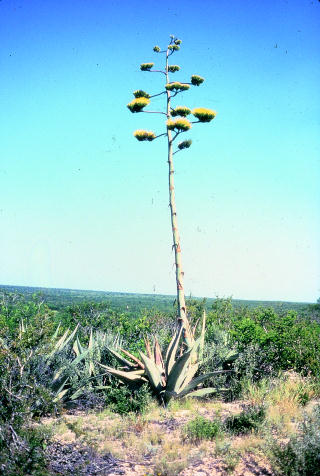
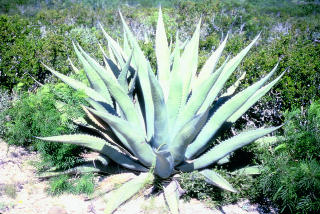
|
Manfreda variegata -
Amaryllidaceae, Amaryllis Family
DESCRIPTION: Leaves in basal rosette, succulent.
Height: To 1 foot, flower stalk to 6 feet.
Flowers: Striking, 8 inch long and 5 inch
wide flower cluster, light yellow
to greenish yellow turning red,
lily-like with showy anthers.
Spring and summer.
Foliage: Looks like that of agaves, 16 inches long, tapering to a point, covered in liver-colored spots.
Fruit: A papery capsule
Growth rate: Slow
REQUIREMENTS:
Sun: Full sun to full shade
Soil: Any
Drainage: Good
Water: Moderate
Maintenance: Remove old flower stalks
Propagation: Seeds, divisions of root offsets
NATIVE HABITAT: Known only along the Lower Rio Grande and in Tamaulipas, Mexico.
WILDLIFE USE: May be a host plant for Manfreda Giant Skipper which is Endangered in Texas due to
habitat destruction.
COMMENTS: Mass plantings may function as ground cover. Mulching around the base shows off leaves.
|
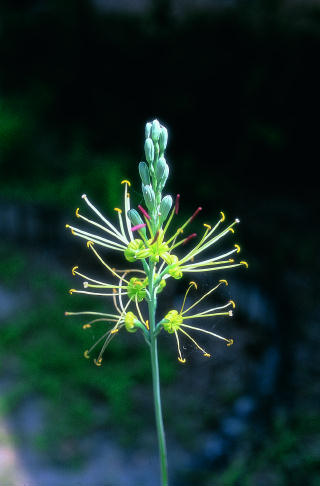
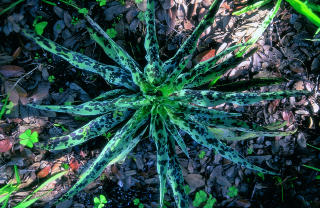
|
Night blooming Cereus, Organo
Acanthocereus pentagonus - Cactaceae, Cactus Family
DESCRIPTION: Upright to prostrate angular five-ribbed cactus that leans or grows on other plants. Will climb a tree. Spines whitish or gray 7 to 8
per cluster.
Height: To 20 feet
Flowers: Large, white blooms 8 inches wide and 3 inches long, flowers at night June through August
Fruit: Bright red, fleshy berry, egg shaped 2-1/2 to 3 inches long
Growth rate: Relatively fast for a cactus
REQUIREMENTS:
Sun: Full sun, to partial sun
Soil: Any
Drainage: Good to moderate
Water: Moderate
Maintenance: Can be encouraged to climb
on any support
Propagation: Seeds, or well healed sections of the cactus
NATIVE HABITAT: Found in coastal portions of Rio Grande Delta.
WILDLIFE USE: The fruit is eaten by bobwhite quail, white-tailed deer,
javelina, raccoon, and other animals. Moths sip the nectar.
COMMENTS: Little of the habitat remains.
|
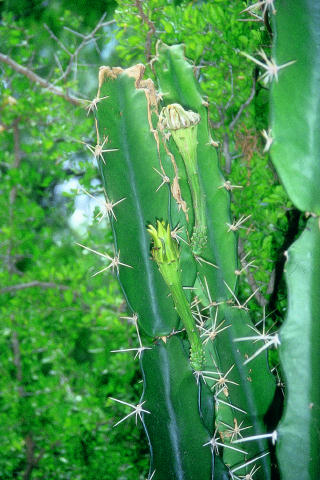
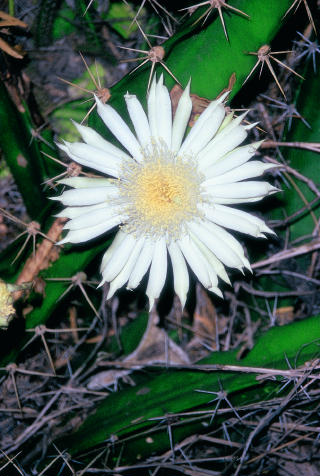
|
Fishhook cactus, Hedgehog cactus
Echinocactus setispinus var. setaceus (Thelocactus setispinus var.
setaceus) - Cactaceae, Cactus Family
DESCRIPTION: Somewhat columnar barrel cactus, central spine is shaped like a fishhook.
Height: To 15 inches tall, usually 12 inches
Flowers: Showy, light yellow with a red throat. February through fall.
Fruit: A small red berry
Growth rate: Slow
REQUIREMENTS:
Sun: Partial sun, morning sun
Soil: Any
Drainage: Good
Water: Do not over water
Maintenance: Best if left alone
Propagation: Seeds
NATIVE HABITAT: Found throughout the Rio Grande Delta in the shade of trees and shrubs.
WILDLIFE USE: Fruit is eaten by birds, small mammals, and Texas tortoises. Bees particularly like this cactus' blooms for the pollen and nectar.
COMMENTS: Three to five flowers, of varying shades of yellow, can appear at one time. As the flowers age, they can take on a rose color.
|
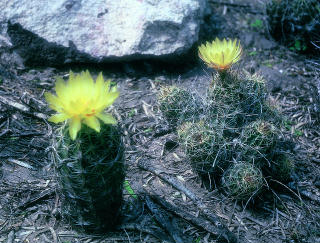
|
Manca Caballo, Devil's Head
Echinocactus texenis - Cactaceae, Cactus Family
DESCRIPTION: Broad, somewhat flattened, round cactus. Stout, reddish spines are flattened and ridged and turn white with age.
Height: To 6 inches tall and 6 to 8
inches across
Flowers: Pink to red-orange, salmon or white, 3 inches wide. February
to April
Fruit: Showy. Red, many-seeded berry,
1-1/2 inches wide
Growth rate: Slow
REQUIREMENTS:
Sun: Full sun to partial sun
Soil: Any
Drainage: Good
Water: Needs some water
Maintenance: Best if left alone
Propagation: Seeds
NATIVE HABITAT: Found throughout the Lower Rio Grande Valley.
WILDLIFE USE: Flowers provide nectar and pollen for bees and other flying insects. Fruit is eaten by Texas tortoises, various birds.
COMMENTS: Get to the emergency room if you step on it barefoot, as serious injury is caused by the strong thorns. Plant out of the way of people, pets and livestock. The fruits are edible and delicious.
|
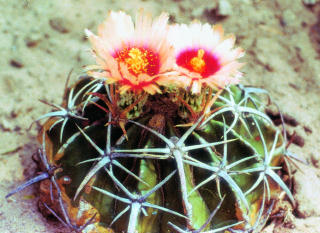
|
Echinocereus berlandieri - Cactaceae, Cactus Family
DESCRIPTION: Cylinder-shaped, prostrate, sprawling, clustering, branching cactus. Older stems lie on the ground
with growing tips erect. Spines are yellow to white with the central spine curved upward.
Height: Prostrate, branches are 6 inches long and 1/2 inch wide
Flowers: Reddish to pink, 3 inches wide with yellow to whitish throat. Usually in March to April.
Fruit: A small green, oval, egg-shaped berry 1/2 to 3/4 inches long
turning red and club-shaped
Growth rate: Slow
REQUIREMENTS:
Sun: Partial sun, NOT full sun
Soil: Any. Usually found in clay soils along arroyo banks.
Drainage: Good
Water: Do not over water
Maintenance: Best if left alone
Propagation: Seeds, or well healed sections of the plant
NATIVE HABITAT: Found throughout the Lower Rio Grande Valley, but most common along the river and its tributaries.
WILDLIFE USE: Bees enjoy nectar and pollen when in bloom.
COMMENTS: An unusual, elegant cactus both in form and in flower.
|
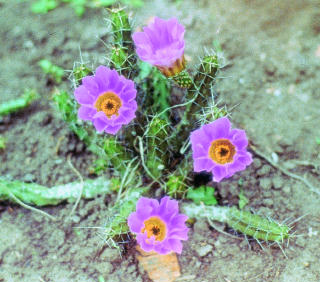
|
Echinocereus blanckii -
Cactaceae, Cactus Family
DESCRIPTION: Young stems erect, then sprawling when older; cylinder-shaped and twisted, 14 inches long and 1 to 2 inches wide. Spines white to brown, or gray, the central spine is curved downward.
Height: To 6 inches.
Flowers: Very large, 3-1/2 inches wide, showy lavender to light purple
with a darker purple throat.
March to May.
Fruit: A small berry that can be greenish, brownish or purplish
Growth rate: Slow
REQUIREMENTS:
Sun: Shade to partial sun, NEVER EVER put in full sun
Soil: Any. Usually found in silty-clay soils by arroyo banks.
Drainage: Good to moderate
Water: Do not over water
Maintenance: Best if left alone
Propagation: Vegetative.
NATIVE HABITAT: Found under brush along Arroyo Colorado in Cameron County,
and westward along Llano Grande Lake and its inlets to south of Alamo, Texas.
WILDLIFE USE: Bees use nectar and pollen. Fruits are eaten by small mammals and Texas tortoises.
COMMENTS: When undisturbed, can form a flat round clump up to 3 feet wide.
|
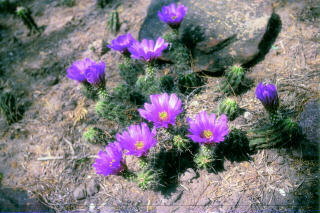
|
Echinocereus enneacanthus - Cactaceae, Cactus Family
DESCRIPTION: Clustering, cylinder-shaped cactus, forming colonies to 3 feet across.
Height: To 1 foot.
Flowers: Very large, pink to purple-red,
3 inches wide with yellow anthers. Spring, usually April.
Fruit: Large round, greenish to brownish to purplish berries, to about
1 inch wide.
Growth rate: Slow
REQUIREMENTS:
Sun: Partial to full sun, best in partial sun
Soil: Any
Drainage: Good
Water: Do not over water
Maintenance: Best if left alone
Propagation: Seeds
NATIVE HABITAT: Found in the eastern Rio Grande Valley and westward to the Big Bend region.
WILDLIFE USE: Flowers provide nectar and pollen for bees and other flying insects. Fruits are eaten by birds, Texas
tortoises and small mammals,
COMMENTS: The flesh of the fruit is edible,
delicious, and tastes much like strawberries.
|
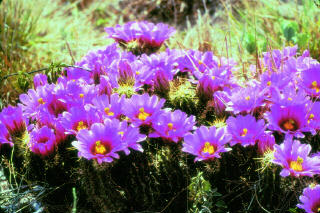
|
Echinocereus papillosus var. angusticeps -
Cactaceae, Cactus Family
DESCRIPTION: Dark green, small, cylinder-shaped, clustering cactus, usually erect but sometimes prostrate. Spines, white to brown or yellow.
Height: Clumps to 4 inches high.
Flowers: Bright yellow, 4 inches wide, with a red to orange throat in early spring.
Fruit: A small green berry covered with short bristles
Growth rate: Slow
REQUIREMENTS:
Sun: Partial sun
Soil: Any
Drainage: Good
Water: Do not over water
Maintenance: Best if left alone
Propagation: Seeds
NATIVE HABITAT: Found in a small area of northwestern Hidalgo County, and a very small area of adjacent Starr County.
WILDLIFE USE: Flowers provide nectar and pollen for bees and other flying insects.
COMMENTS: A cactus with extremely attractive, showy flowers.
|
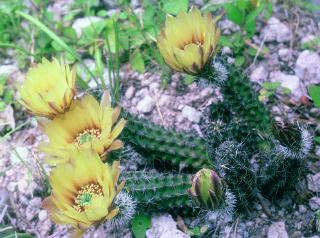
|
NIPPLE CACTUS, Pincushion cactus, Biznaga de
chilitos, Little Chile
Mammillaria heyderi - Cactaceae, Cactus Family
DESCRIPTION: Globose or round-shaped, dark green or bluish-green, central
spines all straight.
Height: To 2-1/2 inches tall and
5 inches across.
Flowers: Small, 1-1/2 inches wide, white, brownish, pinkish, or pale purple. February through April. Form crown like circle around top
of cactus.
Fruit: Small, red, club-shaped
Growth rate: Slow
REQUIREMENTS:
Sun: Partial sun, prefers shade.
Soil: Any, but commonly found
in clay soils
Drainage: Good
Water: Do not over water
Maintenance: Best if left alone
Propagation: Seeds
NATIVE HABITAT: Found throughout the Lower
Rio Grande Valley in the shade
of brush.
WILDLIFE USE: Flowers provide nectar and pollen for insects. Fruit is eaten by birds, small mammals and Texas tortoises.
COMMENTS: Showy flowers followed by a bright red ring of fruit.
|
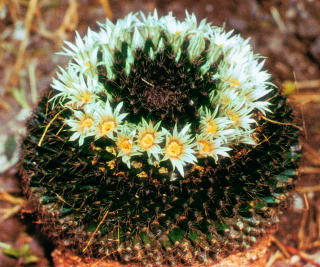
|
Mammillaria runyonii - Cactaceae, Cactus Family
DESCRIPTION: Prostrate nipple cactus to 2 feet across, usually smaller. Central spines 1 to 4, some with hooks.
Height: To 5 inches tall.
Flowers: Showy pink, light purple to purple or rose pink. Spring
Fruit: Oval, 1/2 inch long and green
Growth rate: Slow
REQUIREMENTS:
Sun: Partial sun
Soil: Any
Drainage: Good
Water: Do not over water
Maintenance: Best if left alone
Propagation: Seeds, vegetative divisions, taproot (carrot shaped).
NATIVE HABITAT: Found in extreme southern Rio Grande Plans from Starr to Cameron Counties in gravelly areas.
WILDLIFE USE: Flowers provide nectar and pollen for bees and other flying insects.
COMMENTS: Cactus named in honor of Robert Runyon, a well-known Brownsville, Texas botanist.
|
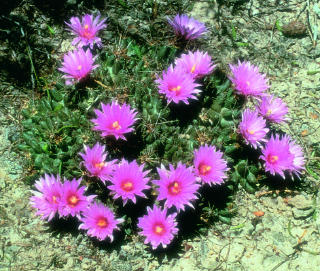
|
Ground Covers
|
Siphonoglossa pilosella - Acanthaceae, Acanthus Family
DESCRIPTION: Low growing, sprawling,
mat-forming, dense ground cover
Height: From 2 to 10 inches
Flowers: Showy, purplish-lilac colored,
2 lipped, 1/2 inch long.
Spring to fall
Fruit: Small inconspicuous capsule
Foliage: Evergreen, elongated oval 1/2 inch long, 1/4 to 1/2 inch wide
Growth rate: Slow to very slow
REQUIREMENTS:
Sun: Full sun, tolerates full shade well
Soil: Any
Drainage: Good to moderate
Water: Moderate
Maintenance: Little needed
Propagation: Seeds, cuttings
NATIVE HABITAT: Brush thickets and near resacas.
WILDLIFE USE: Food for Vesta Crescent, Painted Crescent, Elada Checkerspot, Dymas
Checkerspot, and Rosita Patch caterpillars. Nectar for
small butterflies.
COMMENTS: Tolerates moderate foot traffic
and mowing.
|
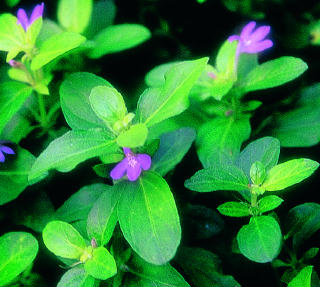
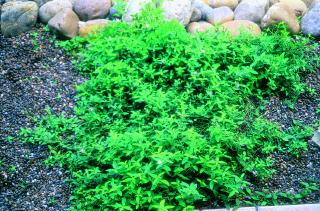
|
PROSTRATE LAWNFLOWER, Horseherb,Hierba del
caballo, Straggler daisy
Calyptocarpus vialis - Compositae (Asteraceae), Composite or Sunflower Family
DESCRIPTION: Herbaceous ground cover, sprawling, weak-stemmed
Height: Low growing to 8 to 10 inches high, usually 3 inches
Flowers: Noticeable small yellow ray flowers. Throughout the year
Fruit: Small inconspicuous capsule
Foliage: Evergreen, simple, light green,
elongated 3/4 inch long and
1/2 inch wide
Growth rate: Moderate to rapid
REQUIREMENTS:
Sun: Partial sun, to partial shade
Soil: Any
Drainage: Good to moderate
Water: Low once established
Maintenance: Little needed
Propagation: Seeds, root divisions
NATIVE HABITAT: Brushlands and disturbed sites
usually in the shade.
WILDLIFE USE: Staple food for Texas tortoise. Flowers provide nectar for small butterflies.
COMMENTS: A suitable flowering ground cover for the shade. Easy to establish in a small area. Difficult to establish in large areas as it does not compete well with broad-leafed weeds. Out competes grass in the shade.
|
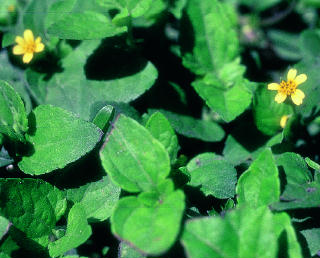
|
Buchloe dactyloides - Gramineae, Grass Family
DESCRIPTION: Low growing, sod-forming, dense ground cover; very attractive
Height: To 6 inches if not mowed
Flowers: Female greenish-yellow hidden among the leaves. Male whitish-green short spikes rising above
the leaves.
Fruit: Small inconspicuous seed
Foliage: Evergreen, grass blades gray-green less than 1/8 inch wide and up to
6 inches long
Growth rate: Slow
REQUIREMENTS:
Sun: Full sun, tolerates some shade
Soil: Any
Drainage: Good to moderate
Water: Not needed once established
Maintenance: Little needed
Propagation: Seeds, plugs with roots, sod
NATIVE HABITAT: Along road-banks throughout the Lower Rio Grande Valley.
WILDLIFE USE: Staple food for Texas tortoise. Grazed by white-tailed deer and cotton-tailed rabbits and a resting place for many species of doves.
COMMENTS: Not aggressive; other grasses will overtake. Tolerates foot traffic. Male sterile varieties better looking.
|
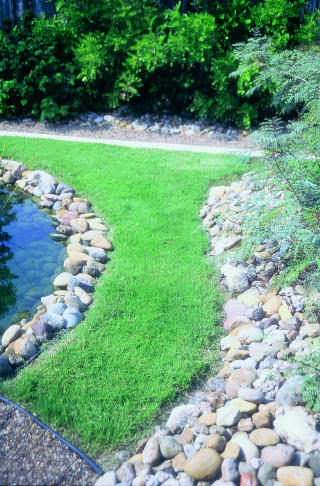
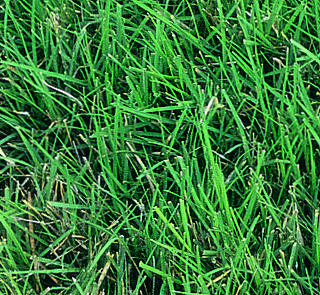
|
Herbaceous mimosa Mimosa strigillosa - Leguminosae
(Fabaceae),
Pea or Pulse Family
DESCRIPTION: Low growing, sprawling ground cover, covered with bristles, but
no spines.
Height: From 1 to 2 inches
Flowers: Showy, globe-shaped, reddish-pink to lavender-rose, 1 inch wide. Spring and summer
Fruit: Small bean pod
Foliage: Small, feathery in appearance,
folding up when touched
Growth rate: Moderate
REQUIREMENTS:
Sun: Full sun
Soil: Any, best in loamy or sandy soil
Drainage: Moderate
Water: Moderate
Maintenance: Little needed
Propagation: Seeds
NATIVE HABITAT: Open areas in sandy woodlands and brush; along roadsides, depressions and along stream or lake banks.
WILDLIFE USE: Leaves eaten by white-tailed
deer and cattle. Food plant
for caterpillars of White-striped Longtail Skipper, Mimosa Yellow and Reakirt's Blue butterflies.
COMMENTS: Very attractive ground cover when in flower. Difficult to establish, but grows well once established.
|
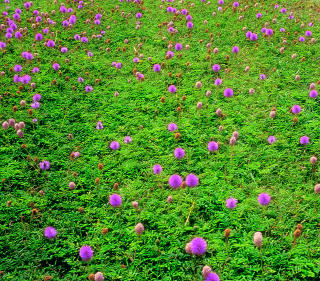
|
CHISME, Moss Rose, Shaggy Portulaca
Portulaca pilosa - Portulacaceae, Purslane Family
DESCRIPTION: Prostrate, succulent ground cover, small, linear, branching from a taproot, forming a flat, circular mass
Height: From 2 to 4 inches
Flowers: Showy, tiny purplish-lilac colored. Spring to fall
Fruit: Small, inconspicuous capsule
Foliage: Evergreen, often crowded, 1/2 inch long and 1/8 inch wide, with wooly hairs at leaf base.
Growth rate: Moderate
REQUIREMENTS:
Sun: Full sun, to partial shade
Soil: Any
Drainage: Good to moderate
Water: Little
Maintenance: Little needed
Propagation: Seeds, cuttings
NATIVE HABITAT: Widespread in various soils.
WILDLIFE USE: White-tailed deer, javelinas, and feral pigs eat the leaves. Scaled quail eat seeds and leaves. Nectar for small butterflies.
COMMENTS: Will do well in extremely dry and rocky areas. Not overly aggressive. Tolerates heavy foot traffic.
|
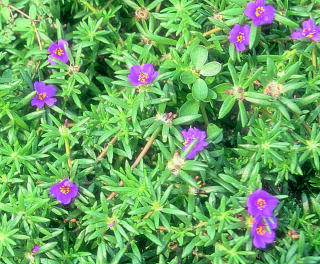
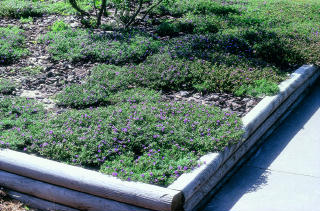
|
Quincula lobata - Solanaceae, Nightshade Family
DESCRIPTION: Low growing, dense, sprawling, mat-forming, ground cover
Height: From 4 to 6 inches
Flowers: Showy, blue to violet, 1 inch wide. All year
Fruit: Small, roundish berry, 1/2 inch wide, 1/2 inch long within an
inflated calyx
Foliage: Evergreen, elongated oval 1/2 inch long, 1/4 to 1/2 inch wide with
wavy margins
Growth rate: Slow to medium
REQUIREMENTS:
Sun: Full sun
Soil: Any
Drainage: Good to moderate
Water: Drought to moderate
Maintenance: Little needed
Propagation: Seeds, cuttings, and stolons
NATIVE HABITAT: Hidalgo County and west, roadside, chaparral and
brushland.
WILDLIFE USE: Eaten occasionally by white-tailed deer.
COMMENTS: Very attractive ground cover for small to medium sized areas. The brilliant blue to violet flowers
contrast nicely with the light to medium-green foliage. Does not tolerate foot traffic.
|
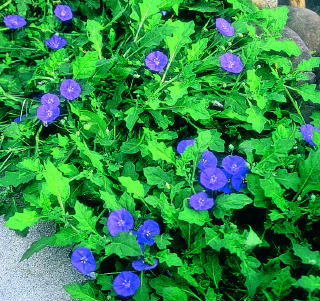
|
Phyla incisa Sawtooth frog-fruit ,Phyla nodiflora Common frog-fruit, Turkey tangle -
Verbenaceae, Vervain or Verbena Family
DESCRIPTION: Low growing, mat-forming, sprawling, or trailing ground cover
Height: From 2 to 8 inches (sun);
P. incisa taller than P. nodiflora.
Flowers: Very small, white, borne in 1/4 to 3/8 inch wide heads. Spring to fall
Fruit: Small, inconspicuous dry nut
Foliage: Evergreen, light green, 1 inch long, 1/2 inch wide, toothed leaf edges. P. nodiflora leaves are broader with teeth widely spaced over most of the leaf edge.
Growth rate: Fast
REQUIREMENTS:
Sun: Full sun, dappled shade
Soil: Any, will tolerate heavy clay soils
Drainage: Good to poorly drained soil
Water: Medium to high
Maintenance: Little needed
Propagation: Seeds, root divisions
NATIVE HABITAT: Along roads, openings and waste places in the Rio Grande Plains and the Coastal Prairies
WILDLIFE USE: White-tailed deer, javelinas, feral pigs and cattle eat the leaves. Food for White Peacock and Phaon Crescent butterfly caterpillars, and nectar for small butterflies.
COMMENTS: The first emergent nectar for most species of butterflies in the Lower Rio Grande Valley after the 1983 and 1989 freezes.
|
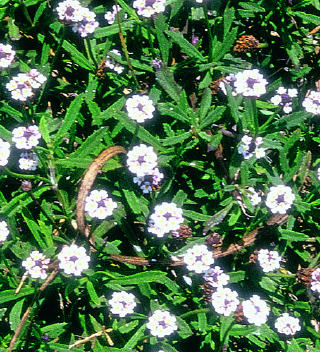
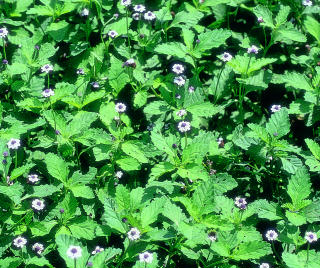
|
VINES
|
Anredera scandens and A. leptostachys - Basellaceae, Madeira Vine Family
DESCRIPTION: Twining vine; shiny, medium to dark green, succulent leaves and showy red fleshy stems, from thick underground tubers.
Height: Climbing vine
Flowers: Small, white to cream colored, fragrant. Flower clusters are elongated in A. leptostachys and compact in A.
scandens. A. leptostachys blooms in the fall, and A. scandens blooms summer through winter.
Fruit: Small, whitish winged seed.
Foliage: Evergreen
Growth rate: Fast
REQUIREMENTS:
Sun: Partial shade to full sun
Soil: Any
Drainage: Good to low. Does well on dry sites
Water: Low, drought tolerant
Maintenance: Little needed
Propagation: Seed, cuttings, dividing tubers
NATIVE HABITAT: Brush - grassland in Cameron, Hidalgo and Starr Counties.
WILDLIFE USE: Dense foliage provides shelter for small animals. Blooms provide
nectar and pollen.
COMMENTS: An attractive ornamental that quickly covers a fence or trellis.
|
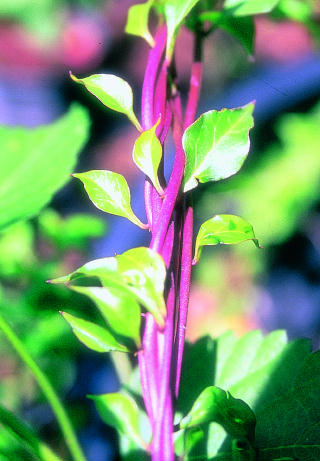
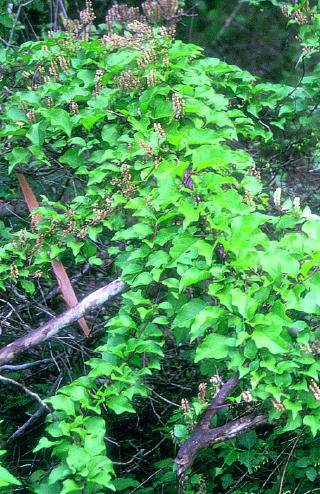
|
Tournefortia volubilis - Boraginaceae, Borage Family
DESCRIPTION: Slender stemmed, twining,
woody vine
Height: Climbing vine
Flowers: Very small, yellowish-white, flowering throughout the year
Fruit: Small, fleshy white berry with one or more black dots at the blossom end; fruits appear in clusters
Foliage: Evergreen, alternate, shiny leaves,
1 to 3 inches long, very slightly hairy above, grayish below.
Growth rate: Fast
REQUIREMENTS:
Sun: Partial shade to full sun
Soil: Any
Drainage: Good to moderate
Water: Low, drought tolerant
Maintenance: Little needed
Propagation: Seed
NATIVE HABITAT: Dense brush and woodlands, along resaca banks and palm groves, mostly found in Cameron County.
WILDLIFE USE: Dense foliage provides shelter for small animals. Blooms provide
nectar and pollen.
COMMENTS: An attractive, thickly growing, climbing vine for use on a trellis or fence. Sensitive to cold below 28 degrees F.
|
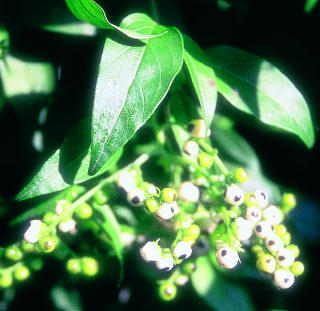
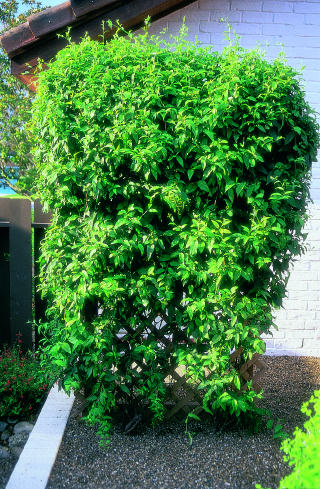
|
Mikania scandens - Compositae, (Asteraceae), Composite or Sunflower Family
DESCRIPTION: Twining vine; somewhat succulent
Height: Climbing vine
Flowers: White, borne in clusters 2 inches wide and 1-1/2 inches long. Spring, summer and fall.
Fruit: Small, inconspicuous achene
or seed
Foliage: Delta-shaped to 3 inches long and 2 inches wide at the base.
Growth rate: Very fast
REQUIREMENTS:
Sun: Full sun to full shade
Soil: Any
Drainage: Moderate to waterlogged
Water: High water requirement for a native
Maintenance: Provide something for it to climb
Propagation: Seeds
NATIVE HABITAT: Rio Grande Delta in areas that stay moist for extended periods.
WILDLIFE USE: Provides food for caterpillars of the Tropical Green Hairstreak and the Anieta butterflies which are very rare strays to the Lower Rio
Grande Valley.
COMMENTS: Flowers all day long.
|
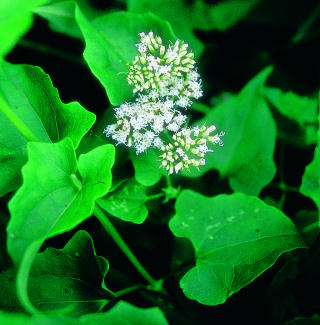
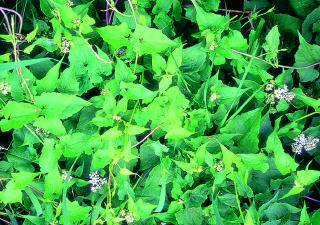
|
Ipomoea imperati - Convolvulaceae, Morning Glory Family
DESCRIPTION: Prostrate, sprawling vine with oval leaves and showy flowers.
Height: To 4 inches
Flowers: Showy, white with a yellow throat, 3 inches long and 3 inches wide. Spring, summer and fall.
Fruit: A somewhat woody capsule
Foliage: Thick, leathery, succulent, oval-shaped, 1-1/2 inches long and
2 inches wide.
Growth rate: Fast
REQUIREMENTS:
Sun: Full sun
Soil: Loose sand
Drainage: Good to moderate
Water: Moderate
Maintenance: Unknown
Propagation: Seeds, tubers, rooting at nodes
NATIVE HABITAT: Cameron and Willacy Counties in coastal sands.
WILDLIFE USE: Food for caterpillars of Painted Crescent butterfly. Flowers provide nectar and pollen for bees and other flying insects.
COMMENTS: This morning glory forms long, trailing vines, covering and securing sand dunes. The dark green leaves contrast nicely with the white, yellow-throated showy flowers.
|
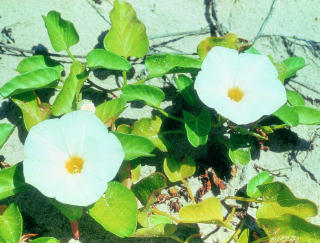
|
Ipomoea pes-caprae - Convolvulaceae, Morning Glory Family
DESCRIPTION: Low growing, mat-forming
vine with circular leaves and
showy flowers
Height: To 6 inches
Flowers: Showy, large purplish-lilac colored, 3 inches long and 3 inches wide. Summer and fall.
Fruit: Woody capsule
Foliage: Evergreen, thick, leathery, circular, notched at the end, 3-1/2 inches long and 4-1/2 inches wide.
Growth rate: Fast
REQUIREMENTS:
Sun: Full sun
Soil: Loose sand
Drainage: Good to moderate
Water: Moderate
Maintenance: Unknown
Propagation: Seeds, tubers, cuttings
NATIVE HABITAT: Cameron County coastal sands.
WILDLIFE USE: Food for caterpillars of Painted Crescent butterflies. Provides nectar and pollen for insects.
COMMENTS: This morning glory vine is indeed glorious. A must in sandy areas or on beach property.
|
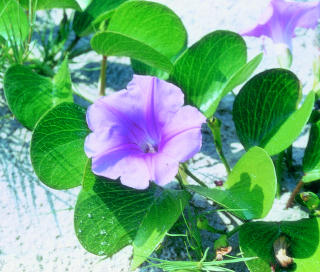
|
Merremia dissecta - Convolvulaceae, Morning Glory Family
DESCRIPTION: Climbing vine with palmate leaves, showy flowers, and an attractive seed pod.
Height: Twining vine
Flowers: Showy, white with a purple throat,
3 inches long and 3 inches wide. Spring, summer and fall. Stay open all day, unlike some Ipomoea species whose flowers close at
mid-day.
Fruit: Woody capsule in the shape of a "wood rose"
Foliage: Palm-shaped leaves to 4 inches long and 4 inches wide. The 5
to 7 lobes have wavy edges with indentations.
Growth rate: Fast
REQUIREMENTS:
Sun: Full sun
Soil: Any
Drainage: Good to moderate
Water: Very drought tolerant
Maintenance: Needs to climb on something
Propagation: Seeds
NATIVE HABITAT: On edges of thickets and disturbed land.
WILDLIFE USE: Provides nectar and pollen for insects and food for caterpillars of Painted Crescent butterfly.
COMMENTS: Dry seed capsules can be used in flower arrangements.
|
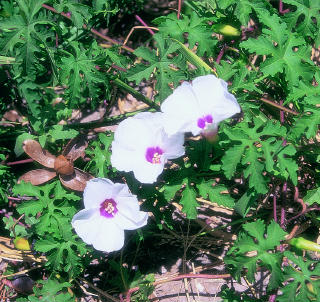
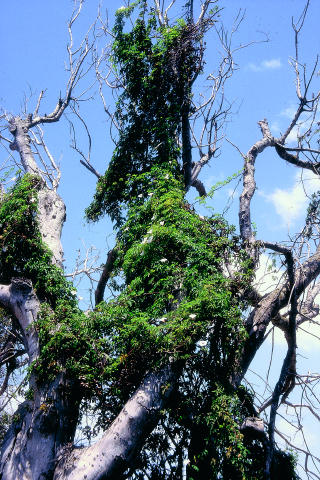
|
Passiflora filipes - Passifloraceae, Passion Flower Family
DESCRIPTION: Attractive, delicate in appearance, twining by tendrils
Height: Climbing vine
Flowers: Small, non-showy yellowish-green, about 3/4 inches wide. Throughout most of the year
Fruit: A small, dark blue berry,
1/2 inch wide
Foliage: Evergreen, attractive 1-1/2 inches long and wide, nearly heart-shaped, with light greenish-white splotches on upper surface
Growth rate: Fast
REQUIREMENTS:
Sun: Shade to partial sun, full
morning sun
Soil: Any
Drainage: Good to moderate
Water: Moderate
Maintenance: Little needed
Propagation: Seeds
NATIVE HABITAT: Resaca woodlands in southern Cameron County
WILDLIFE USE: Food for Heliconian butterflies.
COMMENTS: Most noticeable features are splotches on the leaves and
fragrance of flowers.
|
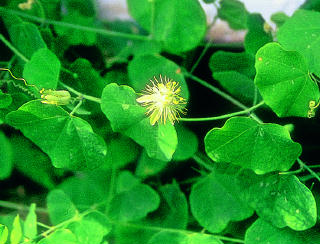
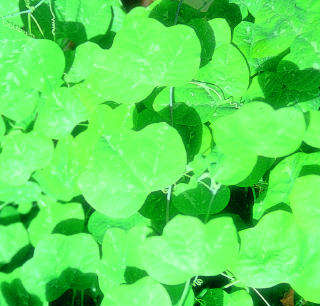
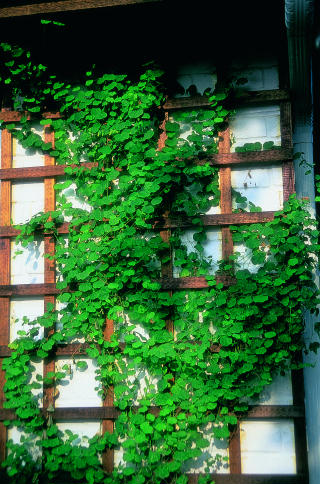
|
Passiflora foetida - Passifloraceae, Passion Flower Family
DESCRIPTION: Attractive, twining by tendrils, vine hairy throughout, often sticky from gland-filled hairs.
Height: Climbing vine
Flowers: Showy, abundant blue, or sometimes white, intricate with several layers of petals; about 1-1/2 inches wide. Throughout most of the year; flowers close by late morning
Fruit: Green, inflated, slightly fleshy,
3/4 inches, oval to round
Foliage: Light-green, hairy, 3-lobed, 3 inches long and 2 inches wide, slightly pungent aroma when crushed
Growth rate: Fast
REQUIREMENTS:
Sun: Full sun, no shade
Soil: Any
Drainage: Good to well
Water: Drought tolerant
Maintenance: A trellis or a fence to climb upon.
Propagation: Seeds
NATIVE HABITAT: Open brushland along fence rows, roadside ditches and thickets.
WILDLIFE USE: Food for caterpillars of Gulf, Variegated and Mexican Fritillary butterflies.
COMMENTS: High phosphorus fertilizer
stimulates flowering.
|
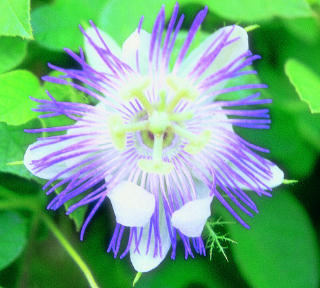
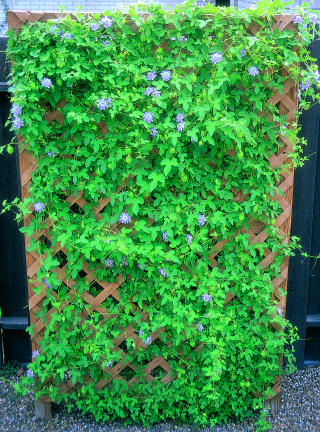
|
Cardiospermum halicacabum - Sapindaceae,Soapberry Family
DESCRIPTION: Woody vine, climbing by tendrils.
Height: Climbing vine
Flowers: Small, white, in bunches, often slightly fragrant. Throughout
the year
Fruit: Attractive, 1/2 to 1 inch oval,
inflated papery pod resembling a small balloon, pinkish on top and greenish on the bottom
Foliage: Evergreen, attractive, three-leaflet clusters, 2 to 5 inches long
and wide
Growth rate: Fast
REQUIREMENTS:
Sun: Full sun to partial shade
Soil: Any
Drainage: Good to moderate
Water: Drought tolerant once established
Maintenance: Little needed
Propagation: Seeds
NATIVE HABITAT: Short brush thickets, along fences and roadsides.
WILDLIFE USE: Food for caterpillars of the Silver-banded Hairstreak and the Mexican Gray Hairstreak butterflies.
COMMENTS: Cold hardy. An excellent choice for a trellis or to cover a fence.
|
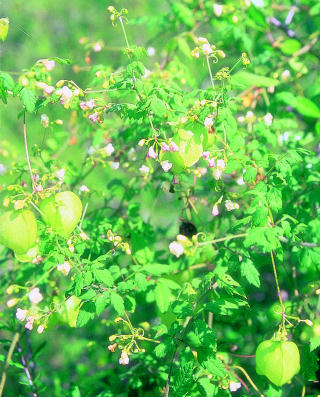
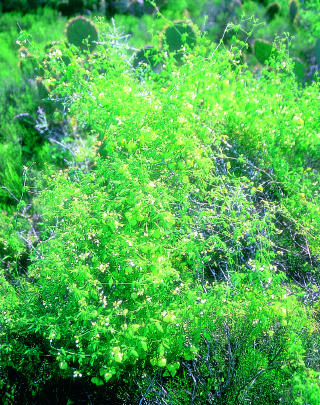
|
Serjania brachycarpa - Sapindaceae, Soapberry Family
DESCRIPTION: Slender, climbing by tendrils , open and woody at base
Height: Climbing vine
Flowers: Small, whitish or greenish-yellow, very fragrant. Summer and fall
Fruit: Papery pod, 1/2 inch long
Foliage: Dark evergreen, three-leaflet
clusters with toothed edges,
3 inches long
Growth rate: Moderate to fast
REQUIREMENTS:
Sun: Full sun (best) to partial shade
Soil: Any
Drainage: Good to moderate
Water: Drought tolerant once established
Maintenance: Little needed
Propagation: Seeds
NATIVE HABITAT: Resaca woodlands and thickets
WILDLIFE USE: Food for caterpillars of Dimophic Bark Wing butterfly.
COMMENTS: An excellent, attractive, fragrant vine for a trellis or fence.
|
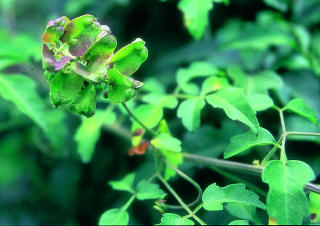
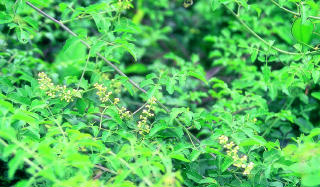
|
|
Ajilvsgi, Geyata. 1991. Wildflowers of Texas, Shearer Publishing: Fredericksburg, TX.
Everitt, J. H. and D. L. Drawe. 1993. Trees, Shrubs & Cacti of South Texas. Texas Tech Univ. Press: Lubbock.
Everitt, J. H., D. L. Drawe and R. I. Lonard. 1999. Field Guide to the Broad-Leaved Herbaceous Plants of South Texas. Texas Tech University Press: Lubbock.
Native Plant Project. 1994. Native Trees of the Lower Rio Grande Valley. Texas. Landscape Uses and Identification. Native Plant Project,
Edinburg.
Native Plant Project. 1996. Native Shrubs of the Lower Rio Grande Valley. Texas. Landscape Uses and Identification. Native Plant Project,
Edinburg.
Neck, R. W. 1996. A Field Guide to the Butterflies of Texas. Gulf Publishing Co.: Houston.
Ogden, Scott. 1998. The Moonlit Garden. Taylor Publishing Co.: Dallas.
Pyle, R. M. 1981. The Audubon Society Field Guide to North American Butterflies. Alfred A. Knopf: New York.
Richardson, A. 1995. Plants of the Rio Grande Delta. University of Texas Press: Austin.
Wasowski, Sally, with Andy Wasowski. 1988. Native Texas Plants: Landscaping Region by Region. Texas Monthly Press, Austin.
The Native Plant Project currently holds general meetings eight times per year. Members are advised of meetings, field trips, and other activities through The
Sabal, which conveys information on the native plants, habitats, and the environment of the Lower Rio Grande Valley, Texas.The Native Plant Project periodically updates and issues lists of endangered species of the Lower Rio Grande Valley and checklists of its woody plants.
Native Plant Project
P. O. Box 2742
San Juan, TX 78589
The Native Plant Project wishes to thank its Board members for producing this handbook.
Valley Nature Center
301 South Border Avenue
P.O. Box 8125
Weslaco, TX 78596
Phone 956-969-2475
Price per handbook is $4.50 plus $0.37 for tax plus $1.00 for postage and handling. A discount is available for an order of multiple copies.
|
|
|
|
|












































